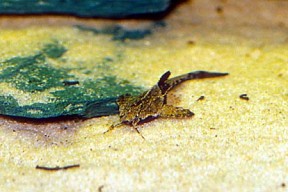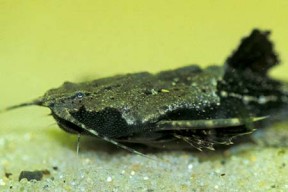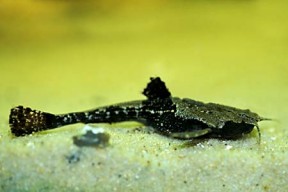Bunocephalus coracoideus
Banjo Catfish
Classification
Aspredinidae. Subfamily: Bunocephalinae
Distribution
Bolivia, Peru and Brazil.
Habitat
Inhabits forest streams, lakes and ponds typified by large amounts of leaf litter, fallen branches and other similar debris.
Maximum Standard Length
6″ (15cm).
Aquarium SizeTop ↑
A largely inactive species requiring relatively little space, given its potential size. An aquarium measuring 24″ x 15″ x 12″ (60cm x 37.5cm x 30cm) – 71 litres is adequate.
Maintenance
Requires plenty of hiding places and dim lighting. Cover can be in the form of a couple of inches of sand as substrate, or crevices amongst rocks and bogwood. A scattering of dried oak or beech leaves over the substrate can look very effective, and will allow it to blend in with its surroundings as it would in nature.
Water Conditions
Temperature: 68-80°F (20-27°C), but aim for the upper end of this range.
pH: 5.8-7.8
Hardness: 2-20°H
Diet
Unfussy but not easily fed due to its sedentary lifestyle. It relishes live and frozen foods such as bloodworm, earthworms etc., as well as sinking dried foods. Add food after lights out to ensure it receives its share.
Behaviour and CompatibilityTop ↑
Will not predate on smaller fish and so is suitable for most community aquaria. Ideally keep it in a South American biotope aquarium, with tetras, dwarf cichlids and other peaceful catfish such as Corydoras sp. and smaller Loricariids. It’s totally unaggressive towards conspecifics, and is equally happy when kept singly, or as part of a group.
Sexual Dimorphism
Difficult to sex, though adult females tend to be larger and rounder-bellied than males.
Reproduction
Rarely achieved in aquaria but possible. It’s best to have group of at least half a dozen mature specimens for a spawning attempt. The fish spawn at night, laying eggs directly onto the substrate. The adults will eat their spawn, so it is recommended to have a spare tank containing identical water to the breeding tank ready. The eggs can then be transferred into this as they appear. They hatch in around 3 days, and once the fry have used up their yolk sacs they will accept microworm or brine shrimp nauplii as first foods.
NotesTop ↑
Bunocephalus is the largest genus within the Aspredinidae family and there are several undescribed species. B. coracoideus is the most common member seen in dealers’ tanks. Its native name “Guitarrita” translates as “little guitar” and refers to the shape of the fish when viewed from above.
Despite the regularity with which it is seen for sale, it isn’t really a good catfish for the general community tank because it’s a largely inactive, secretive species, that will only emerge and become active under cover of darkness. It is, nonetheless, an interesting aquarium subject for the enthusiast, exhibiting an incredible degree of camouflage. Its appearance is designed to resemble a dead leaf and usually the fish will not even swim to escape a net. When released into the aquarium will simply drift in the current until it hits the bottom.
All members of the family occasionally shed their skins, although the exact reasons for this are not known. They also have a novel method of propulsion, taking in water through the mouth and expelling it through the gills, giving them a somewhat jerky swimming action.



